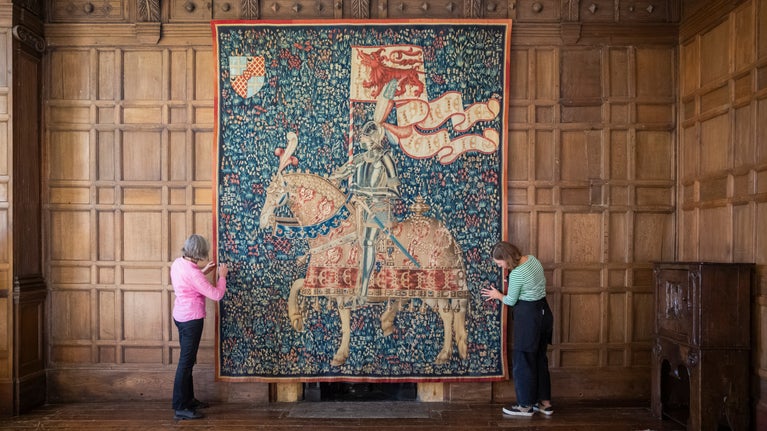
Preserving the past
From conserving historic works of art and delving into archaeology to supporting urban heritage and parks, find out about our vital conservation work.

Conservation Week at Knole: Monday 8 - Sunday 14 September 2025
The Collections and House Team will be working throughout the showrooms, demonstrating how they clean and conserve historic objects. Chat to the team and learn how they care for chairs that once belonged to King James I, artwork by 18th century European masters and wall paintings that have witnessed 400 years of visitors to Knole. Along the way uncover temporary displays that reveal secret drawers, long lost notes and hidden graffiti.
Sally will be carrying out a survey of the metal objects on display in the showrooms and assessing if any conservation work will be required in the future.
These tests involve carefully exposing samples of historic objects to an extreme light source. The effects are monitored and by measuring the change we can determine exactly how sensitive different objects are to light exposure. This will help inform us how we look after these objects in the future.
The Collections and House team will be undertaking cleaning in the showrooms throughout the week. Often this work is done when the showrooms are closed, so this is an opportunity to see the process and chat to the team as they clean textile covers.
Meet the Collections and House team in the Great Hall, where they will be talking to visitors about their roles, collections care processes and showing some of the tools and equipment that they use.
The Collections and House team will be conducting a condition survey and a clean of the carpet in the ballroom.
Throughout the week, some items of furniture will be opened up to reveal hidden details that aren’t usually on view, including secret drawers, long lost notes and hidden graffiti.
On Friday 12 and Sunday 14 September, join Collections Assistant Harry for a new, behind-the-scenes tour highlighting some of the preventive conservation techniques used to care for Knole's collection. Find out how the Collections and House Team mange agents of deterioration and even help by doing a practical condition check exercise towards the end of the tour. You'll also have time to ask questions and pick up some useful tips along the way. This is a free tour but normal admission applies. There are limited spaces available so tickets will be issued from the Visitor Centre on a first come first served basis.
There'll be a different object in focus plus the opportunity to 'meet the conservator' 1-2pm.
Conservator Felicity will be working on the remedial treatment of ceramic objects damaged during a fire at Clandon Park in 2015. Many ceramics made by master craftsmen, for example Meissen, were broken into numerous tiny fragments. So far the project has involved hours of puzzling and piecing together fragments before cleaning and re-adhering the objects.
Join Sarah part way through her treatment of an early Reynolds painting from Saltram House in Devon. Learn about some of the intriguing discoveries made so far by different forms of imaging, and how the conservation of this portrait, alongside curatorial research, might be able to shed light on the on the figure of the enslaved black boy known as ‘Jersey’.
Furniture conservators Nicola and Abi will be showcasing two dramatic pieces of furniture: a 19th century chest from the Royal Sardinian suite adorned with delicate classical gilding, and an elaborate 18th century ivory inlayed cabinet originating from Vizagapatam, India. They'll be demonstrating specialist conservation materials and techniques, and discussing the exciting discoveries made during the technical investigation and treatment that has been carried out.
Treatment on an important late seventeenth-century japanned cabinet and stand from Saltram has just started. The cabinet was made in England using a European technique in imitation of Chinese and Japanese lacquer. Its black, red, and gilded surface is decorated throughout with Chinoiserie figures, flora, and fauna. Its contemporary stand, also made in England, has richly pierced carving and a very rare surviving original gilding using a little-known technique called ‘mecca’, which is silver gilding coated in a yellow translucent glaze intended to look like gold. Both cabinet and stand have been damaged with woodworm and need treatment. During conservation week you can see them up close, discover the decoration in detail, the rare original finish on the stand, and see the cabinet open.

From conserving historic works of art and delving into archaeology to supporting urban heritage and parks, find out about our vital conservation work.
Join Collections Assistant Harry for a behind-the-scenes look at some of the preventive conservation techniques used to care for Knole's collection.

Explore Knole's showrooms to see one of the rarest and most well-preserved collections of Royal Stuart furniture, paintings, objects and textiles – on show since 1605.

Conserving and preserving our history for the future.

Knole is home to some of the last surviving 17th-century furniture from Whitehall and Hampton Court Palaces, among the most expensive status objects of their time.
